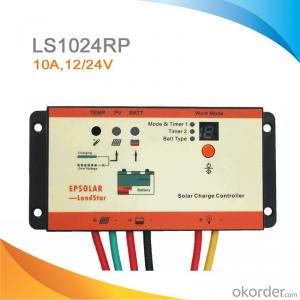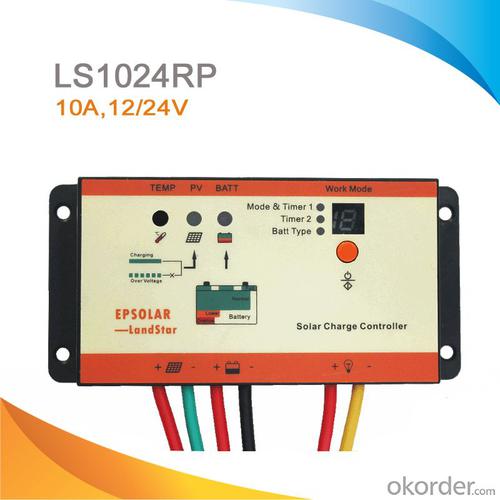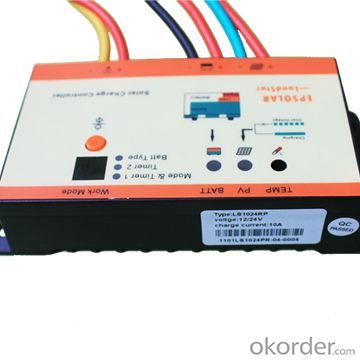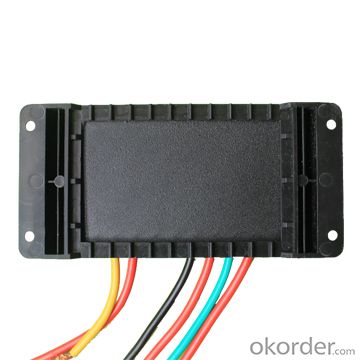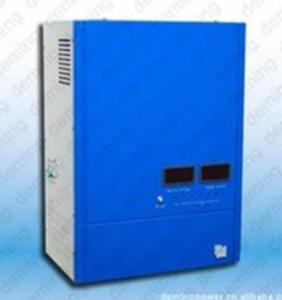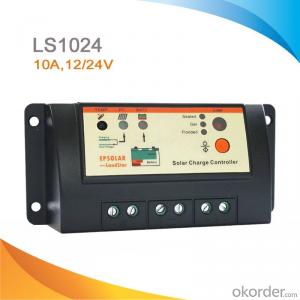Solar Controllers from South Korea Supplier - PWM Waterproof Solar Road Controller, 10A, 12/24V LS1024RP
- Loading Port:
- China main port
- Payment Terms:
- TT or LC
- Min Order Qty:
- -
- Supply Capability:
- -
OKorder Service Pledge
OKorder Financial Service
You Might Also Like
Features:
·Waterproof design
·High efficient Series PWM charging
·Gel, Sealed and Flooded battery type option
·Widely used, automatically recognize day/night
·Intelligent timer function with 1-15 hours option
·Use MOSFET as electronic switch
·Digital LED menu with simple setting and easy using
·Temperature compensation
·Reverse protection: any combination of solar module and battery
Electronic Protections:
·Overheating
·Over discharging
·Over charging
·Load overload
·Load short circuit
·PV short circuit
·PV reverse polarity
·Battery reverse polarity
Specification:
Electrical parameters | LS1024RP | LS2024RP |
Nominal System Voltage | 12 / 24VDC auto work | |
Rated Battery Current | 10A | 20A |
Max. Battery Voltage | 32V | |
Charge Circuit Voltage Drop | ≤0.26V | |
Discharge Circuit Voltage Drop | ≤0.15V | |
Self-consumption | ≤6mA | |
Overall dimension | 145 x 69 x 31mm | 145 x 85x 34mm |
Wire diameter | 4mm2 | 6mm2 |
Net weight | 0.3kg | 0.4kg |
Working temperature | -35℃ to +55℃ | |
Humidity | 10%-90% NC | |
Enclosure | IP66 | |
Battery Voltage Parameters (temperature at 25℃) | |||
Battery charging setting | Gel | Sealed | Flooded |
Equalize Charging Voltage | —— | 14.6V;x2/24V | 14.8V;x2/24V |
Boost Charging Voltage | 14.2V;x2/24V | 14.4V;x2/24V | 14.6V;x2/24V |
Float Charging Voltage | 13.8V;x2/24V | 13.8V;x2/24V | 13.8V;x2/24V |
Low Voltage Reconnect Voltage | 12.6V;x2/24V | 12.6V;x2/24V | 12.6V;x2/24V |
Low Voltage Disconnect Voltage | 11.1V;x2/24V | 11.1V;x2/24V | 11.1V;x2/24V |
Equalize Duration | —— | 2 hours | 2 hours |
Boost Duration | 2 hours | 2 hours | 2 hours |
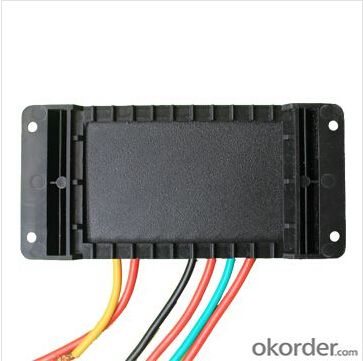
FAQ:
Q1. What is the voltage?
A1. Our 45/60A solar charge controller is 12/24/36/48V auto work.
Q2. What is the difference between MPPT&PWM?
A2. MPPT has higher efficiency, it can track the max power point and won't waste energy.
Q3. What is the efficiency of the MPPT controller?
A3. MPPT>99%, peak conversion efficiency>98%.
Q4. What is the waranty of product?
A4. 12 months.
Q5. What protection does your MPPT controller have?
A5. PV array short circuit, PV reverse polarity, Battery reverse polarity, Over charging, Output short circuit.
- Q: What is the purpose of the battery low voltage disconnect feature on a solar controller?
- The purpose of the battery low voltage disconnect feature on a solar controller is to protect the battery from being over-discharged. It automatically cuts off the power supply to prevent the battery voltage from dropping to a critically low level, which could damage the battery and reduce its lifespan. This feature ensures that the battery remains in a safe operating range and helps to prolong its overall efficiency and performance.
- Q: Can a solar controller be used with a battery bank that is being charged from other sources (e.g., grid, generator)?
- Yes, a solar controller can be used with a battery bank that is being charged from other sources. The solar controller will regulate the charging process and ensure that the battery bank is not overcharged, regardless of whether the charging source is solar panels, the grid, or a generator.
- Q: Can a solar controller be used with a solar-powered heating system?
- Indeed, a solar-powered heating system can make use of a solar controller. This device, recognized as a charge controller, bears the responsibility of managing and overseeing the electricity's passage from the solar panels to the heating system. Its primary function is to guarantee that the solar panels operate at their utmost efficiency, while preventing any potential overcharging of the batteries or the entire system. Through the utilization of a solar controller, the solar-powered heating system can effectively harness the sun's energy and evenly distribute it among the heating components, thus ensuring optimum performance and maximizing energy conservation.
- Q: Can a solar controller be used with different types of batteries (e.g., lead-acid, lithium-ion)?
- Yes, a solar controller can be used with different types of batteries, including lead-acid and lithium-ion. Solar controllers are designed to regulate and control the charging process of batteries, ensuring they are charged at the appropriate voltage and preventing overcharging or undercharging. They can be programmed or adjusted to accommodate the specific charging requirements of different battery types. This flexibility allows users to connect and charge various types of batteries with a single solar controller, making it a versatile and convenient solution for solar power systems.
- Q: Can a solar controller be used with a solar-powered backup generator?
- Yes, a solar controller can be used with a solar-powered backup generator. The solar controller helps regulate and optimize the charging of the battery bank connected to the generator. It ensures that the solar panels are efficiently charging the batteries and prevents overcharging or undercharging, thus extending the lifespan of the batteries and maximizing the generator's performance.
- Q: Can a solar controller be used in a solar-powered electric motorbike racing system?
- Yes, a solar controller can be used in a solar-powered electric motorbike racing system. A solar controller helps regulate the voltage and current from the solar panels to ensure efficient charging of the batteries in the motorbike. It can also provide protection against overcharging and over-discharging of the batteries. Thus, incorporating a solar controller in the racing system can optimize the usage of solar energy and enhance the overall performance of the motorbike.
- Q: Can a solar controller handle power fluctuations from the inverter?
- Yes, a solar controller is designed to handle power fluctuations from the inverter. It regulates and controls the flow of electricity between the solar panels, batteries, and inverter, ensuring stable and consistent power supply even in the presence of fluctuations.
- Q: How does a solar controller handle power surges from the solar panels?
- A solar controller is a critical component in a solar power system that regulates the flow of power from the solar panels to the battery bank or the electrical grid. When it comes to handling power surges from the solar panels, a solar controller plays a crucial role in safeguarding the system. Power surges can occur due to various reasons such as sudden changes in weather conditions, fluctuations in solar radiation, or issues with the solar panel itself. These surges can potentially damage the system and its components if not handled properly. To handle power surges, a solar controller typically incorporates various protective mechanisms. One of the primary functions of a solar controller is to prevent overcharging of the battery bank. When a power surge occurs, the solar controller detects the excess voltage and current and limits the charging rate to ensure that the battery is not overcharged. This helps to maintain the battery's health and prolong its lifespan. Furthermore, solar controllers often include transient voltage suppression devices like surge protectors or voltage clamps. These devices help to absorb and divert excessive voltage spikes away from the system, preventing damage to the solar panels, controller, batteries, or other connected devices. Additionally, some advanced solar controllers employ Maximum Power Point Tracking (MPPT) technology, which optimizes the power output of the solar panels. MPPT controllers can dynamically adjust the voltage and current to maximize the power transfer from the panels to the battery, even during power surges. This technology improves the efficiency of the system while also minimizing the impact of power fluctuations. In conclusion, a solar controller handles power surges from the solar panels by regulating the charging rate to prevent overcharging, incorporating surge protection devices, and utilizing MPPT technology to optimize power output. These protective features ensure the system's stability, protect the components from damage, and maximize the efficiency of the solar power system.
- Q: Can a solar controller be used with a solar-powered recreational facility?
- Yes, a solar controller can be used with a solar-powered recreational facility. A solar controller regulates the flow of electricity from the solar panels to the battery bank, ensuring efficient charging and preventing overcharging or damage to the batteries. It is an essential component in managing the power supply for a solar-powered facility, including recreational facilities such as campsites, sports complexes, or outdoor activity centers.
- Q: How does a solar controller prevent damage from overloading of the load?
- A solar controller prevents damage from overloading of the load by continuously monitoring the current flowing through the system and regulating it to a safe level. It does this by automatically adjusting the voltage and current supplied to the load, ensuring that it does not exceed the controller's maximum capacity. This helps protect the load from excessive power and prevents any potential damage that could occur due to overloading.
Send your message to us
Solar Controllers from South Korea Supplier - PWM Waterproof Solar Road Controller, 10A, 12/24V LS1024RP
- Loading Port:
- China main port
- Payment Terms:
- TT or LC
- Min Order Qty:
- -
- Supply Capability:
- -
OKorder Service Pledge
OKorder Financial Service
Similar products
Hot products
Hot Searches
Related keywords
